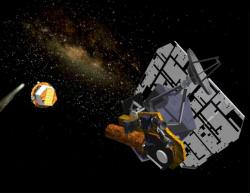It seemed like such a shame. NASA built Deep Impact to see what happens when you smash a refrigerator-sized object into a comet. Mission accomplished, science gathered. But what about the flyby part of the spacecraft? It captured images of the collision with Comet Tempel 1, and then flew on without a target. Well, NASA announced this week that it has a new target: Comet Hartley 2.
Oh, and we don’t call it Deep Impact any more. That was so 2005. Now it’s called EPOXI. And if that sounds like an acronym, you’re right. Here’s the full designation: Extrasolar Planet Observation and Deep Impact Extended Investigation.
EPOXI was originally supposed to meet up with Comet Boethin, but NASA astronomers lost sight of the comet. They lost a comet? Actually, they think it might have broken up into smaller pieces, which are now too small for detection. Unfortunately, this loss pushed back its next cometary encounter by two years.
So the spacecraft is now heading for Comet Hartley 2. If all goes well, it’ll reach the object on October 11, 2010, passing within 1,000 km (620 miles) of the nucleus. As a target for scientific observation, Comet Hartley 2 will do the job nicely. Just like Boethin, it has a small, bright nucleus.
While it’s making this journey, the spacecraft will point the larger of its two telescopes at nearby extrasolar planetary systems, and help gather additional data. It’ll be looking to study the physical properties of giant planets, search for rings and moons and planets as small as three Earth masses.
One intriguing mission will have EPOXI observe the Earth as if it’s an extrasolar planet, to help refine the techniques and data necessary to characterize future terrestrial planet discoveries.
EPOXI made a three-minute rocket burn on November 1st, 2007, putting it on course to reach Hartley 2. Before this encounter, it’ll make three Earth flybys, gathering the additional velocity it needs to reach its meetup with Hartley 2 in 2010.
Original Source: NASA/JPL News Release


Great idea!
Great to make use of all that technology. Even better for me cos the names of my dearly beloved are onboard. The US’s greatest contribution to the world has come from its spaceflight and and science exploration programmes. One day the fact will be appreciated.